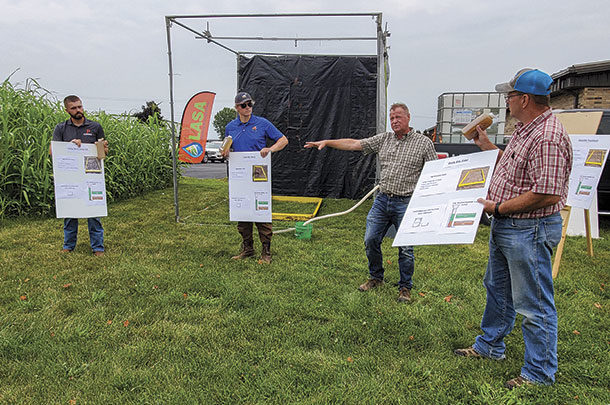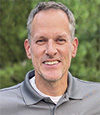With sustainability becoming ever more a focus in the food system, the urgency of creating practical ways to achieve something meaningful is increasing. The calls for progress are growing from customers, communities and regulators. And they want proof.
A group of Wisconsin farmers and partners in the dairy food supply chain feel they have found a promising formula – a framework for conservation projects that protect soil and water quality, keep farms financially viable and document the environmental and financial effects.
The partners developed a guide, “A Framework for Farm-Level Sustainability Projects,” and are piloting it with a dozen farms in a farmer-led watershed conservation group called the Lafayette Ag Stewardship Alliance (LASA).
“The framework is all about making a sustainability project as straightforward as possible,” says Lauren Brey, managing director of Farmers for Sustainable Food (FSF), a nonprofit organization of food system partners.
FSF and Grande Cheese Company worked with LASA to develop the project with the Midwest environmental consulting firm Houston Engineering Inc. A host of other stakeholders are contributing to the initiative as well, from environmental groups and foundations to colleges and food retailers.
Dairy farmer Jim Winn, a participant in the project and LASA’s president, says the framework and pilot project are well suited for his proactive group, which was founded in 2017 to improve water quality in a geologically sensitive part of southwestern Wisconsin. LASA has 31 member livestock and crop farms, including 17 dairies.
“This effort builds on our members’ commitment to environmental stewardship, collaboration and transparency,” Winn says. “The framework gives us a tool to prove to ourselves, our neighbors and those who buy our products that there’s value in being innovative on our farms and in the field.”
Identifying focus areas
The pilot project follows the model of a “milkshed,” which represents the farms and various businesses in a region that furnish dairy foods to customers. Given the differences in farm type, size and location, the project is tailored to individual farms. Eight are dairies.
Doug Thomas, senior project manager at Houston Engineering, describes the structure as a three-legged stool: on-farm sustainability, local environmental resources and business profitability.
Identifying specific focus areas depends on the partners, Thomas says. In the LASA project, the farmers determined that soil erosion and water quality were the biggest resource concerns due to the area’s hilly landscape and abundance of waterways, including designated trout streams. The processor, Grande, had prioritized greenhouse gas emissions, energy use and soil carbon in the company’s sustainability program. So the project was set up to analyze all five aspects.
“That’s an example of the collaborative approach – working first and foremost with the farmers and then some of the partners, like a dairy processor or other businesses in the supply chain,” Thomas says.
He says data underpins it all.
“This is a science-based approach to show how these sustainability metrics and goals are actually being achieved compared to having just anecdotal information.”
The first year of the project wrapped up in 2020, reflecting data collected from the previous year from each farm. The results were encouraging.
Overall, the farms demonstrated that their conservation practices, such as planting cover crops and reducing tillage, contribute to significant reductions in environmental pollutants reaching streams and rivers.
The assessment uses nationally accepted metrics from “Field to Market: The Alliance for Sustainable Agriculture” to address on-farm sustainability indicators, such as greenhouse gas emissions and energy use. A tool called Prioritize, Target and Measure Application (PTMApp) is being used for measuring impact on waterways. The FARM Environmental Stewardship model was used to evaluate greenhouse gas emissions and energy use on several of the farms.
First-year results
A 141-page report details the findings. Among them:
- On average, farms have adopted five conservation practices per field that Field to Market’s Fieldprint Platform recognizes as having a positive impact on sustainability scores.
- Farms with livestock and those that use manure for most crop nutrient needs scored, on average, better than the project benchmark for greenhouse gas emissions and energy use. Manure replaces the use of inorganic forms of nitrogen, which have a higher energy (fossil fuel) cost to produce and ship.
- Existing conservation on the farms is reducing the amount of sediment reaching local streams and rivers by 28%.
- Estimates suggest that by adding cover crops to 50% of all fields in the project area, additional pollution reductions of 40% (sediment), 28% (nitrogen) and 23% (phosphorus) can be achieved.
In addition to the environmental analysis, the project is assessing return on investment for conservation practices for three of the farms. During the first year of the project, farm business management experts at Southwest Wisconsin Technical College established a baseline of data for each farm. Changes will be measured in subsequent years.
Linking the supply chain
The partnering of so many in the supply chain for the initiative – 17 in all – is remarkable.
The Innovation Center for U.S. Dairy acknowledged this when it recognized the effort in June with a national sustainability award for collaboration.
Given the results achieved in year one, the Innovation Center says it’s supporting the extension of the project for two more years as part of the U.S. Dairy Net Zero Initiative (NZI), in which the dairy community has committed to being carbon neutral or better by 2050 by optimizing water usage while maximizing recycling and improving water quality by optimizing the use of manure and nutrients.
“As the dairy industry makes progress toward the collective 2050 Environmental Stewardship Goals, on-farm tools and resources are helping farmers understand their environmental footprint and the best economically viable options for ongoing progress,” says Karen Scanlon, executive vice president of environmental stewardship for the Innovation Center for U.S. Dairy and Dairy Management Inc.
“This farmer-led project demonstrates that whole-farm tools and resources are key to documenting and communicating success,” Scanlon says.
Collaboration is where success lies for sustainability, says Greg Siegenthaler, vice president of milk marketing and supply chain at Grande, an Italian cheese manufacturer in southeastern Wisconsin.
“As with this project, true sustainability efforts will only be realized if the work is done in partnership across our industry and throughout the supply chain,” Siegenthaler says. “In order to really move the needle and see ongoing success around sustainability, we must continue to engage all partners in the process, from farmer-led initiatives that result in greater results for both environmental sustainability and farm financial viability to an ongoing commitment from processors and food manufacturers to engage in the conversation and partner on long-term solutions.”
Nestlé, the world’s largest food and beverage company, is supporting the pilot project as part of its efforts to partner with farmers, suppliers and industry experts to reduce the carbon footprint on farms, an essential element of its strategy to achieve net zero emissions by 2050, says Emily Johannes, senior manager for sustainable sourcing at Nestlé USA.
“Dairy is one of Nestlé’s most important ingredients, and this project demonstrates how collaboration among partners across the supply chain – from farm to fork – can make a difference in creating a more sustainable dairy industry,” Johannes says.
Brey, from Farmers for Sustainable Food, says interest already is growing for similar initiatives: two in Wisconsin and one each in Minnesota and South Dakota.
“This framework is designed to be flexible. Others can take this and replicate their own projects wherever they are,” Brey says. “Many farmers and partners around the country are eager to shape meaningful sustainability efforts, so this framework can provide structure. We want others to take advantage of the work we’ve been doing.”







